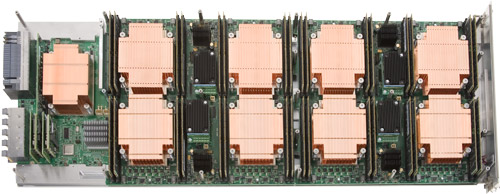About ARCHER

ARCHER is the latest UK National Supercomputing Service. The ARCHER Service started in November 2013 and is due to end operation on 18th February 2020. Planning for the replacement service ARCHER2 is currently ongoing and latest information can be found at https://www.archer.ac.uk/about-archer/news-events/archer2.php.
ARCHER provides a capability resource to allow researchers to run simulations and calculations that require large numbers of processing cores working in a tightly-coupled, parallel fashion.
- Research on ARCHER in The Conversation (April 2014)
- ARCHER supercomputer plays key role in bid to create Google Earth for human body (The Independent)
- The ARCHER YouTube Channel
The ARCHER Service is based around a Cray XC30 supercomputer (more details below) and is provided by the ARCHER Partners: EPSRC, NERC, EPCC, Cray Inc. and The University of Edinburgh. Staff from the partners provide the management, administration, and technical support to keep the system running in a way that maximises the research output of ARCHER. Expertise to support the UK research community in the use of ARCHER is provided by EPCC and Cray Inc. and researchers can also apply for longer term software development support through the eCSE programme.
- eCSE Programme - software development support.
- People - The people who provide the ARCHER service.
- Partners - The partners providing the ARCHER service.
ARCHER Hardware
The ARCHER hardware consists of the Cray XC30 MPP supercomputer, external login nodes and postprocessing nodes, and the associated filesystems. There are 4920 compute nodes in ARCHER phase 2 and each compute node has two 12-core Intel Ivy Bridge series processors giving a total of 118,080 processing cores. Each node has a total of 64 GB of memory with a subset of large memory nodes having 128 GB.
A high-performance Lustre storage system is available to all compute nodes. There is no local disk on the compute nodes as they are housed in 4-node blades (the image below shows an XC30 blade with 4 compute nodes).

Further information on the hardware can be found on the website at:
- Detailed description of the ARCHER hardware
- Description of ARCHER aimed at non-specialists
- ARCHER Best Practise Guide - Getting the most from the ARCHER hardware
ARCHER Software
ARCHER supports a diverse range of applications and simulation software. The major users of the system are materials scientists, climate scientists, physicists, engineers, and biosciences but we also support medical research, industrial simulations amongst many others.
The expertise of ARCHER staff plays a key role in allowing researchers to exploit the computing power available to gain the insights required and drive their investigations forward. This expertise is available every day through the ARCHER Helpdesk and huge range of ARCHER Training (both in person and online). ARCHER recognises that software development is fundamental to computational research and researchers can also apply for funding to support their software development through the eCSE Programme. This provides staff funding for software development projects (typically 6 months to 1 year), the technical staff can be provided within the research group of the applicant, from the ARCHER team, or even by external experts.
- Simulation Software and Applications on ARCHER
- Software catalogue automatically generated from ARCHER
- eCSE Programme
Getting Access to ARCHER
ARCHER is available for use by both academic researchers and industrial users from the UK, Europe and the rest of the world. Please see the pages listed below for more information and contact us if you have any questions.
Policies and Reports
The policies that govern the operation and use of the ARCHER service:
The ARCHER public reports detail the use of the system and provide various statistics on the Service:






